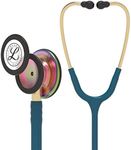Buying Guide for the Best Stethoscopes
Choosing the right stethoscope is important for anyone in the medical field, whether you’re a student, nurse, or doctor. The right stethoscope can make it easier to hear heartbeats, lung sounds, and other important body noises, which helps you make better decisions for your patients. When picking a stethoscope, you should think about where and how you’ll use it, what kind of patients you’ll see, and your own comfort. Understanding the main features will help you find a stethoscope that fits your needs and makes your work easier.Acoustic PerformanceAcoustic performance refers to how well the stethoscope picks up and transmits body sounds to your ears. This is important because clearer sound helps you make more accurate assessments. Stethoscopes can have basic, mid-level, or high acoustic performance. Basic models are fine for simple checks, while high-performance ones are better for detailed listening, like in cardiology. If you need to hear faint or subtle sounds, choose a stethoscope with higher acoustic performance. For general use, a mid-level stethoscope is usually enough.
Chestpiece TypeThe chestpiece is the part you place on the patient, and it usually comes as single-head or dual-head. Single-head chestpieces are simple and good for general use, while dual-head chestpieces have two sides: one for high-pitched sounds and one for low-pitched sounds. If you work in a specialized area or need to listen to a variety of sounds, a dual-head chestpiece gives you more flexibility. For basic exams, a single-head chestpiece is often sufficient.
Diaphragm and BellThe diaphragm is the flat part of the chestpiece that picks up higher-frequency sounds, like normal heartbeats and breath sounds. The bell is the smaller, cup-shaped part that picks up lower-frequency sounds, like some heart murmurs. Some stethoscopes combine both functions in one side, while others have separate sides. If you need to listen to both high and low sounds, look for a stethoscope with both a diaphragm and a bell, or one with a tunable diaphragm that can do both.
Tubing Length and QualityTubing connects the chestpiece to the earpieces and affects both comfort and sound quality. Longer tubing gives you more distance from the patient, which can be useful in some settings, but may slightly reduce sound quality. Shorter tubing usually provides better sound but less reach. Tubing quality also matters—thicker, more durable tubing blocks out background noise and lasts longer. Choose a length that feels comfortable for your work environment, and look for tubing that feels sturdy and flexible.
Earpiece ComfortEarpieces are the parts that go into your ears, and their comfort is important if you use your stethoscope a lot. Soft, well-fitting earpieces help block out noise and make listening more comfortable. Some stethoscopes come with different sizes or types of earpieces so you can find the best fit. If you’ll be wearing your stethoscope for long periods, prioritize comfort and a good seal to avoid ear fatigue.
Weight and DurabilityThe weight of a stethoscope affects how comfortable it is to wear around your neck or carry all day. Lighter stethoscopes are easier to carry, but sometimes heavier models are more durable or have better sound quality. Durability is important if you’ll be using your stethoscope frequently or in busy environments. Think about how much you’ll be carrying it and how rough your work environment is when choosing the right balance between weight and sturdiness.
Intended Use (Adult, Pediatric, or Infant)Some stethoscopes are designed specifically for adults, children, or infants, with chestpieces and diaphragms sized for different body types. If you mostly see adults, a standard stethoscope is fine. If you work with children or babies, look for a pediatric or infant stethoscope, which will make it easier to hear the right sounds and fit smaller bodies. If you see a mix of patients, consider a stethoscope with interchangeable chestpieces or a versatile design.












